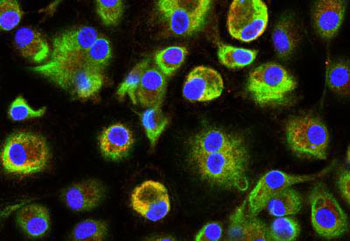Two PARP Family Enzymes Cross-Regulate Macrophage Activation
By LabMedica International staff writers
Posted on 09 Nov 2016
Two of the PARP (poly(ADP-ribose) polymerase) family of enzymes have been identified as being key regulators of the type of macrophage activation that has been linked to development of atherosclerosis.Posted on 09 Nov 2016
PARP enzymes are essential in a number of cellular functions, including expression of inflammatory genes. This protein is found in the nucleus of cells where its primary function is to detect and signal single-strand DNA breaks (SSB) to the enzyme mechanisms involved in SSB repair. PARP activation is an immediate cellular response to metabolic, chemical, or radiation-induced DNA SSB damage. Once PARP detects a SSB, it binds to the DNA, and, after a structural change, begins the synthesis of a poly (ADP-ribose) (PAR) chain as a signal for the other DNA-repairing enzymes. After completing the repair, the PAR chains are degraded via poly (ADP-ribose) glycohydrolase (PARG).

Image: Immunofluorescence staining for PARP9 (red) and PARP14 (green) with nuclei shown in blue (Photo courtesy of Dr. Masanori Aikawa, Brigham and Women\'s Hospital).
Investigators at Brigham and Women's Hospital (Boston, MA, USA) employed advanced proteomic techniques to screen a large number of molecules for their effect on macrophage activation. They reported in the October 31, 2016, online edition of the journal Nature Communications that two members of the PARP family, PARP9 and PARP14, were regulators of macrophage activation, which has been linked to arterial disease by systems biology.
In primary macrophages, PARP9 and PARP14 had opposing roles in macrophage activation. PARP14 silencing induced pro-inflammatory genes and STAT1 phosphorylation in M(interferon-gamma) cells, whereas it suppressed anti-inflammatory gene expression and STAT6 phosphorylation in M(IL-4) cells. PARP9 silencing suppressed pro-inflammatory genes and STAT1 phosphorylation in M(interferon-gamma) cells. PARP14 induced ADP-ribosylation of STAT1, which was suppressed by PARP9. These findings suggested that PARP9 and PARP14 cross-regulated macrophage activation.
"Macrophage activation plays a role in not only vascular disorders but also various inflammatory and autoimmune diseases," said senior author Dr. Masanori Aikawa, director of the center for interdisciplinary cardiovascular sciences at Brigham and Women's Hospital. "These results could provide important information about the mechanisms of these diseases and help to develop much needed new therapeutics."
Related Links:
Brigham and Women's Hospital













